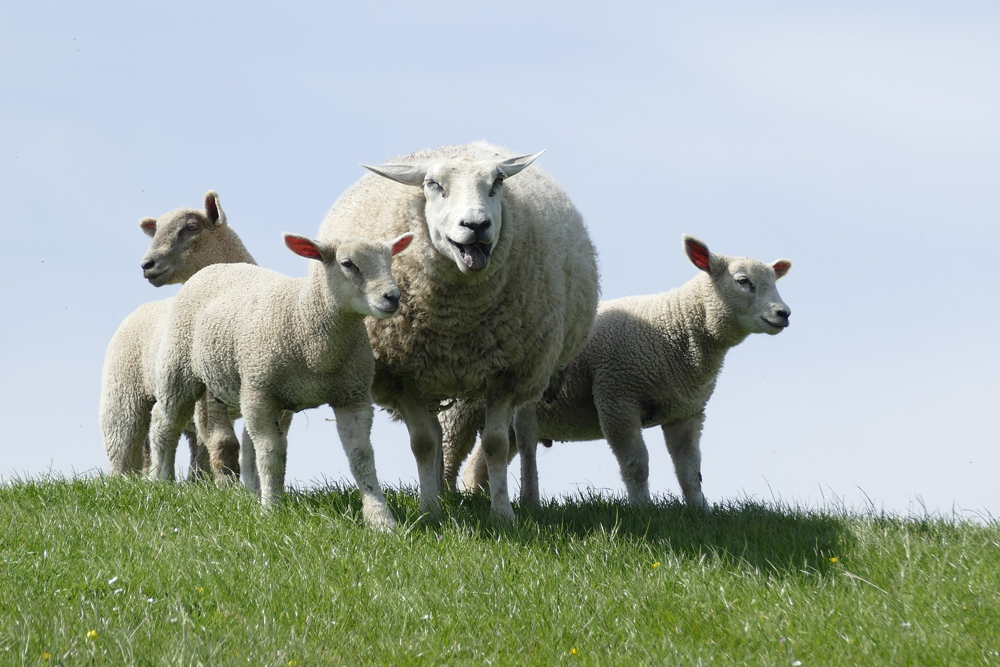by A J Selby.
MARCH – in like a lion, out like a lamb.
The old saying for the month of March is quite apposite given that it’s the busiest month for lambing. Traditionally, spring-born lambs were sold through the late summer and into autumn, depending on the speed of rearing – lowland farms with quality pasture could fatten their lambs quicker than those on the hills, where some lambs wouldn’t be born until April or May and not be ready for a year. Conversely, some shepherds lamb early to produce a small animal for the spring lamb market. How does this happen?
Breed: our local poll Dorset and Dorset horn sheep have the ability to lamb at any time of year and this is controlled by melatonin. This chemical hormone is produced during darkness and therefore most sheep become fertile in the autumn as night-time hours increase, but our Dorsets are related to Spanish sheep where the length of day and night are similar all year round and therefore their melatonin clock is set for those climes.
Dorset sheep can be put to the ram in say, July to give birth in December, wherein the lambs can be fed indoors to meet the Easter Market. Working on a dairy farm in the early 1980s we also ran a small flock of Dorsets that lambed in January. I can still close my eyes and recall the smells and sounds of the lambing shed in the dead of winter, with the warm bodies of the ewes, deep litter straw, wet sugar beet pulp for feed and the background scent of disinfectant.
Some farmers like to ensure that most of the lambs are born in a short time window and to do this they synchronise the breeding of their dams so that they all give birth in a week or so – a busy time for the shepherd but easier to raise the lambs if they are the same age. One method is to ‘sponge’ them – a small ‘sponge’ containing synthetic progesterone is inserted into the ewe with a thin string attached; a couple of weeks later it is gently pulled out and the rams added to the flock two days later. Hey presto, they all come into season together.
A sheep gestates for about 150 days and the easy way to work out due dates is to remember that a sheep that goes to the ‘tup’ – the ram – on bonfire night will give birth on April Fool’s Day. So, if you keep sheep and want them to give birth on March 1, you would put the rams in during the first week of October. To help the shepherd know which ewes have been ‘covered’ – that is, mated – by the tup he may attach a shoulder harness to the ram which is strapped under his front legs and to which is attached a block of coloured crayon. When he jumps the ewes, the crayon rubs off over the top of their tails to show he has done his work.
With more than one ram in the flock, different colours can be used, or the flock-master may change the colours after one 16- or 17-day oestrus cycle to see which sheep have been bred. Once the rams are taken out at the end of the breeding period, the ewes can be scanned to see if they are carrying singles, twins or triplets. This procedure helps the pregnancy management of the flock so that those carrying more than a single lamb can receive some supplementary feed if the grass is of poor quality or the weather is very wet. Ewes with multiple foetuses can be susceptible to pregnancy toxaemia, also known as ‘twin-lamb disease’, where the nutrition in their food is insufficient to sustain the growth of the unborn lambs in the last few weeks of pregnancy when the foetus will make 70% of its growth.
As the lambs grow the ewe will supply them with the extra energy required from her own body fat reserves, which not only makes her thinner but the fat itself is broken down in the liver into ketones, which can poison her if she mobilises too much fat, as she would if carrying twins or triplets. Therefore, identifying ewes with multiple lambs gives the farmer a chance to ensure that she gets a high energy ration.
Soon the ewes and their lambs can get out and graze some spring grass. However, as the days lengthen – so the cold strengthens, as the old saw goes – late March brings the blizzard-white display of the blackthorn and with it, very often, a short cold snap. It’s what we call the blackthorn winter and it’s a small blip in the gradual warming of spring. The blackthorn, of course, is the shrub that produces sloes, so you may console yourself during your spring walks that a good display of blossom may result in a bumper crop to fill your gin bottles in the autumn.











Leave a Reply